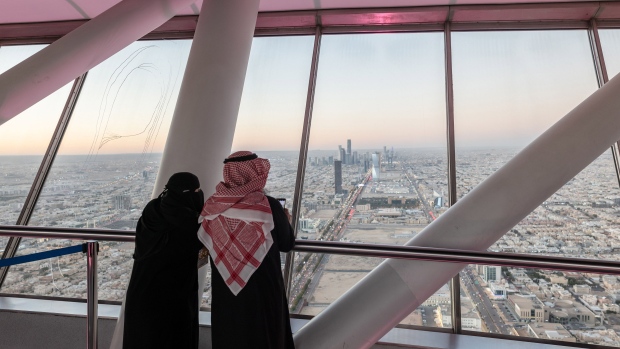May 28, 2023
Saudi Net Reserves Fall to $410 billion, Lowest Since 2010
, Bloomberg News

(Bloomberg) -- Saudi Arabia’s foreign reserves fell in April to the lowest in more than 13 years, in an apparent sign the kingdom hasn’t yet used last year’s $326 billion oil windfall to top up the central bank’s holdings.
Net foreign assets fell to 1.538 trillion riyals ($410 billion) last month, according to the central bank’s monthly report published on Sunday, declining for a fifth month in the longest falling streak since early 2019. Reserves are down more than 44% since peaking in August 2014.
The drawdown, which reached almost $42 billion since November, follows a shift in how the world’s biggest crude exporter manages its oil wealth.
While higher oil prices and output used to quickly translate into rising foreign reserves, officials announced a year ago the kingdom planned to hold on to the money and only later decide how to distribute it. The budget had a surplus of 103.9 billion riyals last year, according to the Finance Ministry.
The government has set the lower and higher bands for the level of reserves it wants to maintain as a share of economic output, according to Finance Minister Mohammed Al-Jadaan, with the goal of protecting public finances from possible shocks.
The stockpile is vital to maintaining confidence in Saudi Arabia’s 3.75-per dollar peg. The riyal’s 12-month forward outright rate was little changed at 3.7505 on Friday, suggesting traders see the peg as solid.
Though Saudi Arabia ran its first budget surplus in nearly a decade last year, it still isn’t clear how it’s allocating the money. Last December, Al-Jadaan said most of it was likely to go to the central bank.
Other potential recipients of transfers include the National Development Fund, which has been tasked with investing in developing the kingdom’s infrastructure, and the Public Investment Fund — the sovereign wealth fund.
Looking ahead, the fiscal outlook is turning less favorable for Saudi Arabia.
The International Monetary Fund forecasts Saudi Arabia will run a budget deficit of 1.1% of gross domestic product this year, a view that’s at odds with the government’s expectation for a second straight surplus it last estimated at 16 billion riyals.
Read More: Saudi Arabia Needs Pricier Oil to Balance Its Budget, IMF Says
The Washington-based lender hiked its estimate of the oil price Saudi Arabia needs to balance its budget this year to over $80 a barrel — above Brent’s current level of around $77. The kingdom doesn’t reveal an oil price assumption in its budget.
Read More: Saudi Arabia Budget Slips into Deficit as Spending Accelerates
Saudi Arabia returned to the debt market earlier this month by selling $6 billion of Islamic bonds. The kingdom already reported a deficit of 2.91 billion riyals in the first quarter of the year.
--With assistance from Paul Wallace.
(Updates with charts)
©2023 Bloomberg L.P.






